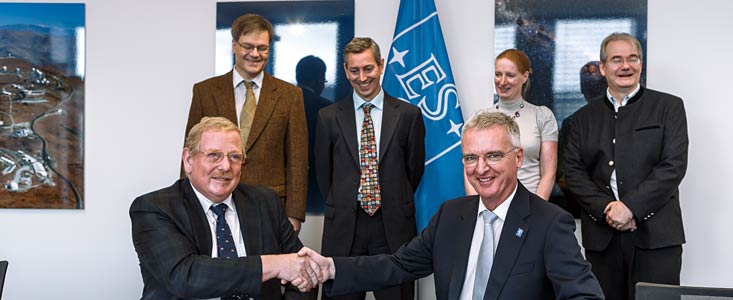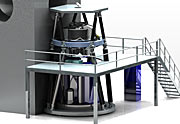Mitteilung
Vereinbarung über die MICADO-Kamera für das E-ELT unterzeichnet
18. September 2015
Die ESO hat eine Vereinbarung mit einem Konsortium europäischer Institute [1] für die Konzeption und den Bau der Kamera MICADO (Multi-AO Imaging Camera for Deep Observations) unterzeichnet. Die Kamera gehört zu den First Light-Instrumenten des European Extremely Large Telescope (E-ELT). MICADO wird die erste, speziell dem riesigen Teleskop zugeordnete, abbildende Kamera sein, die die Leistungsfähigkeit der adaptiven Optik auf die nächste Stufe anheben wird.
Die Vereinbarung wurde von Reinhard Genzel, dem Direktor des Max-Planck-Instituts für extraterrestrische Physik als Vertreter des Konsortiums, und Tim de Zeeuw, dem Generaldirektor der ESO, bei einer Zeremonie am ESO-Hauptsitz am 18. September 2015 unterzeichnet. Auch der Projektleiter von MICADO, Richard Davies, war anwesend.
Durch MICADO wird das E-ELT direkt beim First Light die Möglichkeit besitzen, beugungsbegrenzte Bilder im Bereich nah-infraroter Wellenlängen aufzunehmen. Bei dem Entwurf von MICADO wurde besonders der Wunsch nach hoher Empfindlichkeit und Auflösung, astrometrischer Genauigkeit und die Abdeckung eines großen spektroskopischen Wellenlängenbereichs berücksichtigt.
MICADO ist optimiert für die Verwendung mit dem MAORY-System (Multi-conjugate Adaptive Optics RelaY), einem neuen Modul für die adaptive Optik mit einem Laserleitstern für das E-ELT. Die Kamera kann aber auch in anderen adaptiven Optik-Modi betrieben werden.
Durch MICADO kann das gesamte Auflösungspotential des riesigen Teleskops auf viele aktuelle Forschungsfelder übertragen werden. Dazu zählen die Abbildung detaillierter Galaxiestrukturen bei großen Rotverschiebungen, die Untersuchung von einzelnen Sternen in nahen Galaxien und, im koronografischen Modus, die Entdeckung und Charakterisierung von Exoplaneten. Mit MICADO steht außerdem ein einzigartiges Werkzeug für die Erforschung von Umgebungen zur Verfügung, in denen Gravitationskräfte extrem stark sind, wie beispielsweise in der Nähe von supermassereichen Schwarzen Löchern im Zentrum unserer Galaxie, der Milchstraße.
Zusätzlich zu der primären Abbildungsaufgabe besitzt MICADO auch einen Einzelspalt-Spektrografen, der besonders für die Aufzeichnung von Spektren kompakter Objekte geeignet ist. Dieser Modus wird für viele Gebiete der Astronomie Verwendung finden. Dazu zählen die Messung der Massen von zentralen Schwarzen Löchern in nahen Galaxien von den Geschwindigkeiten ihrer Sterne sowie die Beobachtung von stark rotverschobenen Galaxien, um ihr Alter, die chemische Zusammensetzung und ihre Geschichten zu untersuchen. Das Instrument wird auch Spektren von Supernovae aufnehmen, die von der ersten Generation von massereichen Sternen im Universum erzeugt wurden.
MICADO ist die Krönung der umfassenden, jahrelangen Entwicklungsarbeit von der ESO und der astronomischen Gemeinschaft der letzten Jahre. Insbesondere zu Beginn der Entwicklung wurden die Studien von Sandro D'Odorico angestoßen.
Endnote
[1] Das MICADO-Konsortium setzt sich zusammen aus: MPE: Max-Planck-Institut für extraterrestrische Physik (Deutschland); MPIA: Max-Planck-Institut für Astronomie (Deutschland); USM: Universitäts-Sternwarte München (Deutschland); IAG: Georg-August-Universität Göttingen Stiftung Öffentlichen Rechts ( Ausführendes Institut: Institut für Astrophysik) (Deutschland); NOVA: Nederlandse Onderzoekschool voor de Astronomie (Niederlande); CNRS/INSU: Centre National de la Recherche Scientifique/Institut National des Sciences de l’Univers (representing LESIA, GEPI und IPAG) (Frankreich); A*: Eine österreichische Kollaboration, die durch die Universität Wien repräsentiert wird (zu der A*-Kollaboration zählen die Universität Wien, die Universität Innsbruck, die Universität Graz, die Universität Linz und RICAM Linz [Österreichische Akademie der Wissenschaften]. Beiträge zu MICADO kommen aus Wien, Innsbruck und Linz.) (Österreich), und INAF-OAPD: Nationales Institut für Astrophysik an der Sternwarte Padua (Italien).
Links
- MICADO-Webseite der ESO
- MICADO: the E-ELT Adaptive Optics Imaging Camera (Davies et al., 2010)
- MICADO (Max-Planck-Institut für extraterrestrische Physik)
- MICADO an der Universität Göttingen
Kontaktinformationen
Ric Davies
MICADO Principal Investigator
Max-Planck-Institut für extraterrestrische Physik
Garching bei München
Tel: +49 89 30000 3298
E-Mail: davies@mpe.mpg.de
Hannelore Haemmerle
MPE Press Officer
Max-Planck-Institut für extraterrestrische Physik
Garching bei München
E-Mail: hanneh@mpe.mpg.de
Suzanne Ramsay
ESO Project Scientist
Garching bei München
Tel: +49 89 3200 6665
E-Mail: sramsay@eso.org
Richard Hook
ESO Public Information Officer
Garching bei München
Tel: +49 89 3200 6655
Mobil: +49 151 1537 3591
E-Mail: rhook@eso.org
Über die Mitteilung
| ID: | ann15068 |
Our use of Cookies
We use cookies that are essential for accessing our websites and using our services. We also use cookies to analyse, measure and improve our websites’ performance, to enable content sharing via social media and to display media content hosted on third-party platforms.
ESO Cookies Policy
The European Organisation for Astronomical Research in the Southern Hemisphere (ESO) is the pre-eminent intergovernmental science and technology organisation in astronomy. It carries out an ambitious programme focused on the design, construction and operation of powerful ground-based observing facilities for astronomy.
This Cookies Policy is intended to provide clarity by outlining the cookies used on the ESO public websites, their functions, the options you have for controlling them, and the ways you can contact us for additional details.
What are cookies?
Cookies are small pieces of data stored on your device by websites you visit. They serve various purposes, such as remembering login credentials and preferences and enhance your browsing experience.
Categories of cookies we use
Essential cookies (always active): These cookies are strictly necessary for the proper functioning of our website. Without these cookies, the website cannot operate correctly, and certain services, such as logging in or accessing secure areas, may not be available; because they are essential for the website’s operation, they cannot be disabled.
Functional Cookies: These cookies enhance your browsing experience by enabling additional features and personalization, such as remembering your preferences and settings. While not strictly necessary for the website to function, they improve usability and convenience; these cookies are only placed if you provide your consent.
Analytics cookies: These cookies collect information about how visitors interact with our website, such as which pages are visited most often and how users navigate the site. This data helps us improve website performance, optimize content, and enhance the user experience; these cookies are only placed if you provide your consent. We use the following analytics cookies.
Matomo Cookies:
This website uses Matomo (formerly Piwik), an open source software which enables the statistical analysis of website visits. Matomo uses cookies (text files) which are saved on your computer and which allow us to analyze how you use our website. The website user information generated by the cookies will only be saved on the servers of our IT Department. We use this information to analyze www.eso.org visits and to prepare reports on website activities. These data will not be disclosed to third parties.
On behalf of ESO, Matomo will use this information for the purpose of evaluating your use of the website, compiling reports on website activity and providing other services relating to website activity and internet usage.
Matomo cookies settings:
Additional Third-party cookies on ESO websites: some of our pages display content from external providers, e.g. YouTube.
Such third-party services are outside of ESO control and may, at any time, change their terms of service, use of cookies, etc.
YouTube: Some videos on the ESO website are embedded from ESO’s official YouTube channel. We have enabled YouTube’s privacy-enhanced mode, meaning that no cookies are set unless the user actively clicks on the video to play it. Additionally, in this mode, YouTube does not store any personally identifiable cookie data for embedded video playbacks. For more details, please refer to YouTube’s embedding videos information page.
Cookies can also be classified based on the following elements.
Regarding the domain, there are:
- First-party cookies, set by the website you are currently visiting. They are stored by the same domain that you are browsing and are used to enhance your experience on that site;
- Third-party cookies, set by a domain other than the one you are currently visiting.
As for their duration, cookies can be:
- Browser-session cookies, which are deleted when the user closes the browser;
- Stored cookies, which stay on the user's device for a predetermined period of time.
How to manage cookies
Cookie settings: You can modify your cookie choices for the ESO webpages at any time by clicking on the link Cookie settings at the bottom of any page.
In your browser: If you wish to delete cookies or instruct your browser to delete or block cookies by default, please visit the help pages of your browser:
Please be aware that if you delete or decline cookies, certain functionalities of our website may be not be available and your browsing experience may be affected.
You can set most browsers to prevent any cookies being placed on your device, but you may then have to manually adjust some preferences every time you visit a site/page. And some services and functionalities may not work properly at all (e.g. profile logging-in, shop check out).
Updates to the ESO Cookies Policy
The ESO Cookies Policy may be subject to future updates, which will be made available on this page.
Additional information
For any queries related to cookies, please contact: pdprATesoDOTorg.
As ESO public webpages are managed by our Department of Communication, your questions will be dealt with the support of the said Department.





